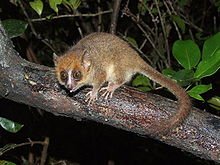 |
| Grey Mouse Lemur |
 |
| M.myoxinus |
• Genus Cheirogaleus (Dwarf lemurs) – 5 species
 |
| Cheirogaleus medius |
Video of mouse lemurs courting here: http://www.youtube.com/watch?v=E5THG8UWs1A
• Genus Mirza (Giant Mouse Lemurs) – 2 species
 |
| Mirza coquereli |
 |
| Allocebus trichotis |
- Genus Phaner (Fork-Crowned Lemurs) – 4 species
 |
| Phaner sp. feeding on gum |
The various Cheirogaleids seem to mostly have a more or less ‘standard’ small primate diet of a mixture of fruits, flowers, insects and small vertebrates, though possibly with various specialisations to avoid competition between related species. M.murinus for example appears to be an adaptable generalist, able to survive even in quite degraded forests, whereas some of its close relatives in the same genus appear to coexist with it and have different ecological strategies. Perhaps the most dietarily specialised of the group are the Fork-Crowned Lemurs, Phaner spp., which seem to be specialists in gum feeding.
One of the unique features of the whole family is the ability of many of the species to go into torpor to conserve energy. In this state, which sometimes lasts for months depending on the local climate, they slow down their metabolism, and their body temperature fluctuates with the environment. In some species when they enter torpor is decided by the seasons, others do it on a daily basis, and there can even be variation within a species depending on the local environment. Some species, notably the Fat-Tailed Dwarf Lemur Cheirgaleus medius, store fat reserves in their tails to help tide them over the dry season when food is short.
The known diversity of identified Microcebus species has increased exponentially in recent years. Not long ago they were all believed to belong to M.murinus, but in the last 10 years or so it has become apparent that as well as the widespread and adaptable M.murinus, the genus contains a huge number of more specialised forms with highly restricted ranges. In view of the massive deforestation in Madagascar in the last 2000 years, it is more or less certain that at least as many species as survive today, probably many more, have become extinct without ever being described.
The more specialised species differ in a variety of ways from M.murinus. While the latter usually sleeps during the day in tree holes, other forms may use tangles of vines, dense foliage, or hide under loose bark. The specific forest type they choose may also differ, with specialists in dry forest, lowland rain forest, and other habitat types. It is highly likely that some are dietary specialists as well, but not enough studies have been done to be more certain as to their preferences.
In captivity, Grey Mouse Lemurs breed sufficiently well to have been used as lab animals in some studies on aging. Each female can produce twins annually, but they are seasonal breeders and careful control of day length is necessary to ensure males and females are in breeding condition at the same time.
Mouse lemurs are rather variable in how sociable they are. Males once they leave the birth nest seem to be more or less solitary, but groups containing multiple females have been observed in the wild. It appears that during the breeding season all males in the vicinity of an oestrus female will compete for access, and fights can occur, both between males and between unwilling females and males. Interestingly, as with many lemur species, it appears that the females are the dominant sex, and in cases of competition or conflict with males they almost invariably win.
In captivity this translates into a need to manage animals living in groups carefully, and to ensure that there are multiple sleeping sites and avenues for escape during the breeding season. Lifespan is not as long as for larger primates, but still long for a small mammal – up to 15 years has been recorded. Unfortunately, they can be prone to stress related disorders if kept in unsuitable groups, which shortens their potential lifespan. The captive diet is a mixture of fruits, primate pellets, and insects, with vitamin supplements also available.
Nest week, perhaps the most instantly recognisable of lemurs, the Ring-Tailed Lemur.
Further reading: North American Cheirogaleid Studbook http://library.sandiegozoo.org/studbooks/primates/cheirogaleid2003.pdf
(images from wikipedia, bbc.co.uk)
No comments:
Post a Comment